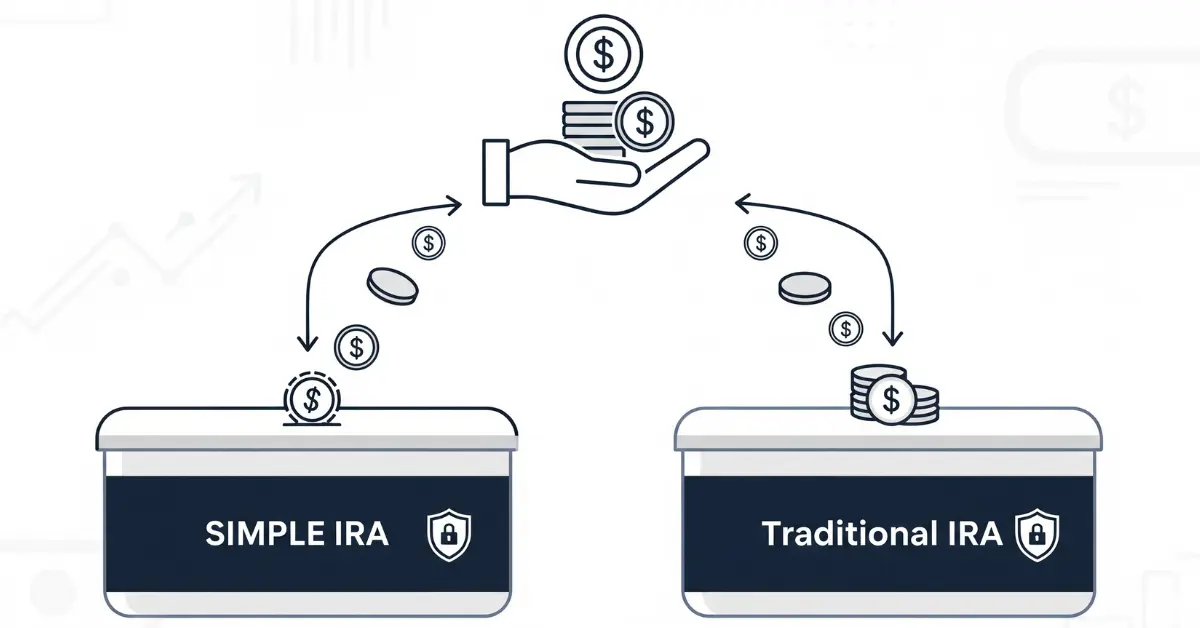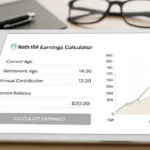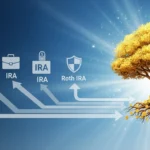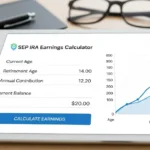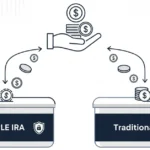Welcome to smartretireplans.com!
Planning for your retirement often involves juggling different savings options to maximize your growth and tax advantages. If you’re self-employed, work for a small business, or even have a side hustle, you might be wondering about the interaction between different types of retirement accounts. A common question that arises is:
“Can I contribute to a SIMPLE IRA and a Traditional IRA in the same year?”
This is a smart question that delves into the specifics of IRS rules governing retirement savings. The answer, like many things in the world of finance, isn’t a simple yes or no. It depends on your individual circumstances, specifically whether you are contributing to the SIMPLE IRA as an employee or as a self-employed individual/employer.
In this comprehensive, human-friendly guide, we will break down the rules and provide clarity on this important topic. We’ll cover:
- The key features of both SIMPLE IRAs and Traditional IRAs.
- The specific rules regarding contributing to both in the same year, depending on your role.
- How your participation in one plan might affect your ability to deduct contributions to the other.
- Important considerations for self-employed individuals and small business owners.
- Strategies to maximize your retirement savings within the IRS guidelines.
Let’s navigate these rules together and ensure you’re making the most of your retirement savings opportunities.
Understanding the Basics: SIMPLE IRA vs. Traditional IRA
Before we dive into the specifics of contributing to both in the same year, let’s briefly recap the key features of each retirement plan.
SIMPLE IRA (Savings Incentive Match Plan for Employees)
A SIMPLE IRA is a retirement plan that can be adopted by small businesses and self-employed individuals. It’s designed to be easier to set up and maintain than traditional 401(k) plans.
Key Features of a SIMPLE IRA:
- Employer Contributions: Employers are required to make contributions for eligible employees, either through a matching contribution or a non-elective contribution.
- Employee Contributions (Salary Deferrals): Employees can choose to make pre-tax contributions from their salary, up to an annual limit.
- Lower Administrative Burden: Compared to 401(k)s, SIMPLE IRAs have fewer administrative requirements, making them attractive to small businesses.
- Contribution Limits: The annual contribution limits for employees are typically lower than those for 401(k)s but can still be significant.
- Who Can Contribute: Small businesses (including self-employed individuals acting as both employer and employee) can establish SIMPLE IRAs.
Traditional IRA (Individual Retirement Arrangement)
A Traditional IRA is a personal retirement account that anyone under age 75 (as of the end of the tax year) with taxable compensation can contribute to.
Key Features of a Traditional IRA:
- Individual Account: You set up and manage this account yourself at a financial institution.
- Tax-Deductible Contributions (Potentially): Contributions may be tax-deductible, depending on your income and whether you (or your spouse, if married) are covered by a retirement plan at work.
- Tax-Deferred Growth: Your money grows tax-deferred until you withdraw it in retirement.
- Annual Contribution Limits: The IRS sets annual limits on how much you can contribute.
- Who Can Contribute: Individuals with taxable compensation who meet the age requirements.
The Core Question: Contributing to Both in the Same Year
Now, let’s tackle the main question: Can you contribute to both a SIMPLE IRA and a Traditional IRA in the same year?
The answer depends on your role in the SIMPLE IRA:
Scenario 1: You are contributing to a SIMPLE IRA as an Employee
If you are an employee of a small business that offers a SIMPLE IRA, and you are making salary deferrals into that plan, you can also contribute to a Traditional IRA in the same year, provided you meet the eligibility requirements for the Traditional IRA (i.e., have taxable compensation and are under age 75).
Important Considerations:
- Contribution Limits Apply Separately: The annual contribution limits for the SIMPLE IRA and the Traditional IRA are separate. Contributing to one does not reduce the amount you can contribute to the other (up to the respective limits). For 2025, the employee contribution limit for a SIMPLE IRA is $16,000 (with an additional $3,500 catch-up for those age 50 and over). The 2025 contribution limit for a Traditional IRA is $7,000 (with an additional $1,000 catch-up for those age 50 and over).
- Tax Deductibility of Traditional IRA Contributions: While you can contribute to both, your participation in a retirement plan at work (like a SIMPLE IRA) can affect whether your contributions to a Traditional IRA are tax-deductible. If you (or your spouse, if married) are covered by a retirement plan at work, your ability to deduct Traditional IRA contributions is limited by your Modified Adjusted Gross Income (MAGI). There are specific income thresholds that determine whether your deduction is full, partial, or not allowed at all.
- If your income is below a certain threshold, your Traditional IRA contributions will likely be fully deductible.
- If your income is above a certain threshold, you may not be able to deduct any of your Traditional IRA contributions.
- If your income falls within the phase-out range, you may be able to deduct a partial amount.
Scenario 2: You are contributing to a SIMPLE IRA as a Self-Employed Individual (Employer)
If you are self-employed and have established a SIMPLE IRA for your business (covering yourself as both the employer and the employee), you can also contribute to a Traditional IRA in the same year, again, provided you meet the eligibility requirements for the Traditional IRA.
Important Considerations (Similar to the Employee Scenario):
- Separate Contribution Limits: Your contributions as the “employee” into your own SIMPLE IRA (salary deferrals) are subject to the SIMPLE IRA limits. Any contributions you make to a Traditional IRA are subject to the separate Traditional IRA limits. Your employer contributions to the SIMPLE IRA do not count towards your Traditional IRA contribution limit.
- Tax Deductibility of Traditional IRA Contributions: Just like an employee covered by a workplace retirement plan, your participation in your own SIMPLE IRA as a self-employed individual can impact the deductibility of your Traditional IRA contributions. Your MAGI will determine whether your Traditional IRA contributions are fully deductible, partially deductible, or not deductible.
In summary: As long as you have taxable compensation and meet the age requirements for a Traditional IRA, you can generally contribute to both a SIMPLE IRA (as an employee or self-employed individual) and a Traditional IRA in the same year. The key factor to be aware of is how your coverage under the SIMPLE IRA might affect the tax deductibility of your Traditional IRA contributions based on your income.
Diving Deeper: The Impact on Traditional IRA Deduction
Let’s elaborate on how your participation in a SIMPLE IRA can affect your ability to deduct contributions to a Traditional IRA.
When you (or your spouse) are covered by a retirement plan at work (which includes a SIMPLE IRA), the deductibility of your Traditional IRA contributions is phased out as your income increases. These income thresholds are adjusted annually by the IRS.
To determine if your Traditional IRA contributions are deductible, you’ll need to know your Modified Adjusted Gross Income (MAGI). This is usually your Adjusted Gross Income (AGI) with certain deductions added back (check IRS Form 8606 instructions for the exact calculation).
Once you have your MAGI, you can compare it to the IRS’s income phase-out ranges for the year. These ranges vary based on your filing status (single, married filing jointly, etc.).
- If your MAGI is below the lower end of the phase-out range: Your Traditional IRA contributions are likely fully deductible.
- If your MAGI is within the phase-out range: You may be able to deduct a partial amount. You’ll need to use a specific IRS worksheet (found in Publication 590-A) to calculate the deductible amount.
- If your MAGI is above the upper end of the phase-out range: Your Traditional IRA contributions are generally not deductible. You can still make non-deductible contributions to a Traditional IRA, which will grow tax-deferred, and the earnings will not be taxed until withdrawal.
Example:
Let’s say in 2025, you are single and covered by a SIMPLE IRA through your employer. The IRS might set the income phase-out range for deducting Traditional IRA contributions for single filers covered by a workplace plan between $77,000 and $87,000 (these are hypothetical numbers, always check the official IRS guidelines).
- If your MAGI is $70,000, your Traditional IRA contributions would likely be fully deductible.
- If your MAGI is $82,000, your deduction would be limited.
- If your MAGI is $90,000, you likely wouldn’t be able to deduct any of your Traditional IRA contributions.
Special Considerations for Self-Employed Individuals
If you are self-employed and have a SIMPLE IRA, you are considered covered by a retirement plan at work. Therefore, your ability to deduct Traditional IRA contributions will still be subject to the income phase-out rules based on your filing status and MAGI.
However, as a self-employed individual, you have more direct control over your income and contributions to your SIMPLE IRA. You might have the flexibility to adjust your SIMPLE IRA contributions (within the limits) in a way that helps you manage your MAGI and potentially maximize your Traditional IRA deduction. This requires careful planning and understanding of your overall tax situation.
Strategies to Maximize Retirement Savings
Given these rules, here are some strategies to consider if you are eligible to contribute to both a SIMPLE IRA and a Traditional IRA:
- Prioritize Employer Contributions to the SIMPLE IRA: If you are an employee, make sure you are taking full advantage of any employer matching or non-elective contributions to your SIMPLE IRA. This is essentially “free money” towards your retirement.
- Contribute the Maximum to the SIMPLE IRA (Employee Deferrals): If your budget allows, aim to contribute the maximum employee deferral amount to your SIMPLE IRA. This grows tax-deferred and can significantly boost your retirement savings.
- Assess Traditional IRA Deduction Eligibility: Once you’ve determined your SIMPLE IRA contributions, estimate your MAGI to see if you are eligible for a full or partial deduction for your Traditional IRA contributions.
- Consider a Non-Deductible Traditional IRA: If your income is too high to deduct Traditional IRA contributions, you can still make non-deductible contributions. These contributions will grow tax-deferred, and when you withdraw them in retirement, the portion representing your original contributions will not be taxed again (only the earnings will be taxed). This can still be a valuable way to save, especially if you don’t have other tax-advantaged options available.
- Evaluate a Roth IRA: If your income is below the Roth IRA contribution limits, you might consider contributing to a Roth IRA instead of a non-deductible Traditional IRA. Roth IRA contributions are not tax-deductible, but qualified withdrawals in retirement are completely tax-free. This can be particularly beneficial if you expect your tax rate to be higher in retirement.
- Plan Your Income Strategically (Self-Employed): As a self-employed individual, you might have some control over your income and business expenses. Strategic planning could potentially help you manage your MAGI to fall within a range that allows for a Traditional IRA deduction. Consult with a tax advisor for personalized guidance.
Conclusion: Can I Contribute to a SIMPLE IRA and a Traditional IRA in the Same Year?
The ability to contribute to both a SIMPLE IRA and a Traditional IRA in the same year provides a valuable opportunity to increase your retirement savings. However, it’s crucial to understand the rules, especially regarding the tax deductibility of your Traditional IRA contributions when you are also covered by a workplace retirement plan like a SIMPLE IRA.
By carefully considering your income, contribution limits, and the potential tax implications, you can develop a smart retirement savings strategy that maximizes your benefits and helps you build a secure financial future. Remember to consult the official IRS guidelines and consider seeking advice from a qualified financial advisor or tax professional for personalized guidance based on your specific circumstances.
At smartretireplans.com, we are committed to providing you with the knowledge and resources you need to make informed decisions about your retirement. Keep exploring our articles for more insights and strategies to help you achieve your financial goals.
FAQ
What happens if I contribute to a Traditional IRA and I’m not eligible for a deduction due to my SIMPLE IRA coverage and income?
You can still make a non-deductible contribution to your Traditional IRA. This contribution will grow tax-deferred, and when you take withdrawals in retirement, the portion of the withdrawal representing your original non-deductible contributions will not be taxed again. You’ll need to file Form 8606 with your tax return to report these non-deductible contributions.
Are the contribution limits for SIMPLE IRAs and Traditional IRAs combined?
No, the annual contribution limits for SIMPLE IRAs and Traditional IRAs are separate. You can contribute up to the maximum allowed for each, provided you meet the eligibility requirements.
If my spouse is covered by a SIMPLE IRA, does that affect my ability to deduct my Traditional IRA contributions?
Yes, if you are married and your spouse is covered by a retirement plan at work (like a SIMPLE IRA), your ability to deduct your own Traditional IRA contributions is also subject to income phase-out rules, even if you are not covered by a plan at work yourself. The income thresholds for married couples are different from those for single filers.
Can a self-employed individual have both a SIMPLE IRA and a SEP IRA in the same year?
Generally, no. You typically cannot establish and contribute to both a SIMPLE IRA and a SEP IRA for the same business in the same year. You usually need to choose one or the other.
Where can I find the official IRS income phase-out ranges for deducting Traditional IRA contributions?
The official income phase-out ranges are published annually by the IRS in publications such as Publication 590-A, Contributions to Individual Retirement Arrangements (IRAs). You can find the most up-to-date information on the IRS website (irs.gov).
